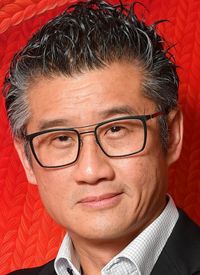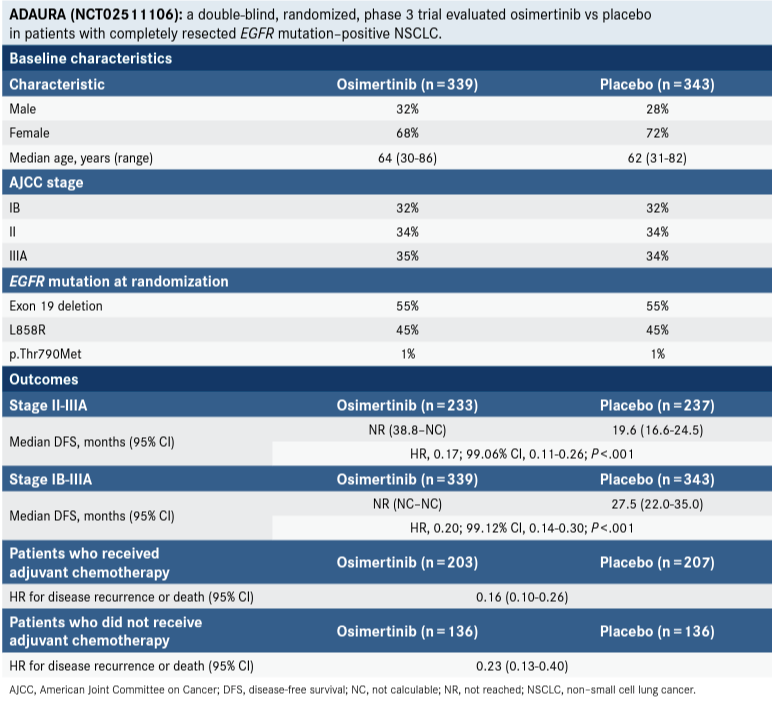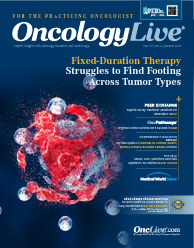Publication
Article
Oncology Live®
Experts Survey Treatment Variations for Resectable NSCLC in Asian Populations
Author(s):
A panel of lung cancer experts from China, South Korea, and Japan share their insights on how they care for their patients with resectable EGFR-positive non–small cell lung cancer.
Tony SK Mok, MD

Since the discovery of EGFR driver mutations nearly 2 decades ago, the scope of treatment for patients with non–small cell lung cancer (NSCLC) has undergone a revolution.1 These mutations are frequent in many Asian populations with NSCLC, observed in 47% to 64% of East Asian patients and in 22% of South Asian patients (ie, India) vs 10% to 20% of White patients,1,2 making them an especially important consideration across East Asia.
The emergences of several EGFR-targeted therapies have improved outcomes for patients. However, approvals for these agents vary across regions.
During an OncLive Peer Exchange®, a panel of lung cancer experts from China, South Korea, and Japan shared their insights on how they care for their patients with resectable EGFR-positive NSCLC.
They examined how treatment strategies differ between countries, including treatment of stage IB disease, use of postoperative therapy in stage III disease, and the use of EGFR tyrosine kinase inhibitors (TKIs) in the adjuvant setting. They also discussed the role of molecular testing in postoperative NSCLC, when to involve multidisciplinary care teams, and the diverging use of neoadjuvant therapy.
Adjuvant Treatment Strategies for Resectable NSCLC
To reduce the risk of recurrence and metastasis, postoperative adjuvant treatment is recommended for patients with stage IIB to IIIA disease or partly stage IB and IIA disease with NSCLC who have undergone radical surgical resection.3 “For [patients with] resectable lung cancer, the guidelines indicate that for stage II and stage III [disease], the standard of care is adjuvant chemotherapy,” Yi-Long Wu, MD, PhD, said, adding that in China, this recommendation also extends to patients with high-risk stage IB disease. However, he noted that he does not use adjuvant chemotherapy for these patients. He said that in China, adjuvant use of gefitinib (Iressa) or osimertinib (Tagrisso) instead of chemotherapy has been approved for patients with EGFR-positive resected stage II to IIIA disease (N1-N2) based on data from the ADJUVANT/CTONG1104 (NCT01405079) and ADAURA (NCT02511106) trials, respectively.4,5
Shun Lu, MD, PhD, who also practices in China, said his institution follows a similar practice as Wu’s, but noted that adjuvant chemotherapy is sometimes recommended for high-risk patients with stage IB disease. He also noted that the icotinib, a f irst-generation TKI, is available to treat patients with stage II to III EGFR-mutant NSCLC.
In South Korea, the adjuvant chemotherapy recommendations mirror China’s. “All patients who have [had their disease] resected, from stage IB to IIIA, should receive adjuvant chemotherapy first line as long as they have good performance status,” Myung-Ju Ahn, MD, said. When considering patients with stage IB disease, her institution, like Lu’s, administers adjuvant chemotherapy to patients with high-risk disease, which she said is any patient with a tumor measuring greater than 4 cm. For patients with EGFR mutations, Ahn said osimertinib is the only TKI approved in South Korea for these patients but is not yet reimbursed.
In contrast, in Japan, osimertinib has not yet been approved as an adjuvant treatment for EGFR-mutated NSCLC, but an application for this indication has been submitted.6 “We can’t use any TKI for [patients with] EGFR-mutated [disease],” Tetsuya Mitsudomi, MD, PhD, said. Instead, Mitsudomi explained that for patients with stage IB disease without lymph node metastasis, tegafur and uracil (UFT) is used. UFT, an oral anticancer drug developed in Japan, consists of a combination of the 5-fluorouracil congener prodrug tegafur (tetrahydrofuranyl-5-fluorouracil) and uracil (1:4), with the uracil used to enhance the Tetsuya Mitsudomi, MD, PhD anticancer effects of tegafur.7,8 For patients with stage II and III NSCLC, Mitsudomi said a cisplatin doublet, such as cisplatin plus vinorelbine, is typically used. This is the preferred regimen, as cisplatin plus pemetrexed did not show benefit.
Postoperative Radiotherapy in Stage III NSCLC
The panelists agreed that postoperative radiation is best reserved for patients with incomplete or uncertain resections, rather than the general population of patients with resectable stage III NSCLC. This consensus was partially based on findings from the LUNG ART study (NCT00410683), a phase 3 European randomized trial evaluating modern postoperative conformal radiotherapy (PORT) in patients with completely resected NSCLC and mediastinal N2 involvement.9 Results showed no overall survival (OS) benefit with the addition of PORT, although there was a nonstatistically significant 15% increase in disease-free survival (DFS) among patients with stage III (N2) disease.
“If the surgeon thinks the patient has a high possibility of local recurrence when they do surgery, then we give radiation. Other than that, we don’t routinely use postoperative radiation [in South Korea],” Ahn said. Wu agreed and said that in China, PORT is used only when resection is uncertain or incomplete, noting that data from a Chinese radiotherapy trial showed similar findings to LUNG ART. “There was no OS benefit from the postradiotherapy for N2 [disease] data,” he said.
Similarly, Mitsudomi said postoperative radiation is almost never used for N2 disease in Japan. He noted that this was the case even before the LUNG ART study data became available and said that the Japan Society of Clinical Oncology is currently conducting its own radiation study.
Using EGFR TKIs in the Adjuvant Setting
The role of EGFR TKIs in the NSCLC setting continues to evolve, with the third-generation agent, osimertinib, generating considerable excitement among the panelists. Osimertinib showed benefit as an adjuvant treatment for patients with EGFR-positive resectable NSCLC in the double-blind, phase 3 ADAURA trial.5
ADAURA randomly assigned 682 patients with completely resected EGFR-positive NSCLC 1:1 to receive adjuvant osimertinib 80 mg once daily (n = 339) or matching placebo (n = 343) for 3 years.5 The primary end point was DFS among patients with stage II to IIIA disease. Secondary end points included DFS in the overall study population (stage IB to IIIA disease), OS, and safety. Adjuvant platinum-based chemotherapy was allowed and was administered to 76% of patients with stage II to IIIA disease (n = 466) and 26% of patients with stage IB disease (n = 216).5
Among the patients with stage II to IIIA disease, 90% of the patients in the osimertinib arm were alive and disease free at 24-month follow-up compared with 44% of those in the placebo arm (HR for disease recurrence or death, 0.17; 99.06% CI, 0.11-0.26; P < .001). When examining the entire study population, 89% of the patients in the osimertinib arm and 52% of patients in the placebo arm were alive and disease free at 24 months (HR for disease recurrence or death, 0.20; 99.12% CI, 0.14-0.30; P < .001). Wu said that although these findings demonstrated the relapse rate to be reduced by 80%, they are not related to the use of adjuvant chemotherapy (Table5).
Table. ADAURA Trial Snapshot5

Tony SK Mok, MD, unpacked this further, noting that although ADAURA is one of the most important studies in the past few years in terms of moving treatment forward for patients with resectable EGFR-mutated NSCLC, it is not without some controversy. For example, he noted one challenge is with the trial design, which made chemotherapy optional before randomization, leading to confusion about chemotherapy. “Where should we not give chemotherapy before we give osimertinib? How do we decide whether to give chemotherapy?” Mok said.
Ahn explained that controversy over when to use chemotherapy remains in South Korea. However, she emphasized that chemotherapy is the only treatment to show a survival benefit thus far, albeit low (4%-5%). Subsequently, she said chemotherapy should be given before osimertinib whenever possible but noted that this has been difficult to put into practice because many patients prefer oral agents. In such cases, she said giving osimertinib without chemotherapy is acceptable because analyses have shown a DFS benefit regardless of whether chemotherapy is administered.
Mitsudomi agreed with this approach. “We should give chemotherapy because of the design of studies such as [ADAURA]. The study showed that osimertinib is beneficial even without chemotherapy. So if a patient refused [chemotherapy], they are not fit to receive cisplatin-based therapy, or they are too old, then I’m happy to keep osimertinib alone,” he said.
Mok proceeded to ask the panelists whether any first-generation EGFR TKIs such as gefitinib or icotinib, which are both approved in China, still have a role in the adjuvant treatment of EGFR-mutated resectable NSCLC in the osimertinib era. Lu noted these first-generation agents continue to be used in China because they are reimbursed, whereas osimertinib is not.
In terms of OS, he said none of the first-generation agents have shown an OS benefit but they delay disease progression. In data from a 2021 meta-analysis by Chinese investigators that included data from 5 studies examining various EGFR TKIs as adjuvant therapy in EGFR-positive early-stage NSCLC (stage IB to IIIA), the HR for DFS was 0.38 (95% CI, 0.22-0.63), in favor of EGFR TKIs.3 The studies in the meta-analysis included ADAURA assessing osimertinib, ADJUVANT/CTONG1104 and Li 2014 assessing gefitinib, and EVAN (NCT01683175) and RADIANT (NCT00373425) assessing erlotinib (Tarceva). All studies except for ADAURA were included in the OS analysis, which revealed a 39% reduction in the risk of all-cause death in patients treated with adjuvant EGFR TKIs compared with those in control groups, but this finding did not reach statistical significance (HR, 0.61; 95% CI, 0.31-1.22).3
Survival data for osimertinib are still awaited. Mok suspects they may show an OS benefit vs the first-generation agents, because osimertinib has been shown to penetrate the central nervous system (CNS). “I predict the CNS protection will probably contribute to the overall benefit of the drug,” he said. Wu agreed, noting that a model developed to predict OS based on the available ADAURA trial data suggest an OS benefit.
Molecular Testing in Postoperative NSCLC
When discussing the use of routine molecular testing following surgical resection, in addition to testing for EGFR mutations, Lu said he will test for ALK gene rearrangements, which have been observed in 4% to 5% of patients with NSCLC.10,11 He explained these patients tend to relapse quickly with adjuvant chemotherapy but ALK-positive tumors respond well to small-molecule ALK inhibitors, so he tries to identify candidates for this treatment. He mentioned enrolling patients in the ongoing phase 3 ALINA trial (NCT03456076), in which investigators are evaluating the efficacy and safety of alectinib (Alecensa) compared with platinum-based chemotherapy in the adjuvant setting for patients with stage IB to IIIA ALK-positive NSCLC.11 The trial has completed enrollment.
Mitsudomi said molecular testing before a recurrence is not routinely done in Japan because treatment options remain limited. “We can’t use gefitinib, osimertinib, alectinib, or any of these kinds of drugs after the surgery. They are not approved [or] reimbursed. That rule is very strict in Japan,” he said. Nevertheless, he said some physicians in Japan will proactively test patients with advanced disease who are at high risk of recurrence so they can plan the next treatment for when the patient recurs following adjuvant chemotherapy. In South Korea, Ahn said she routinely tests patients for EGFR mutations, ALK gene rearrangements, and PD-L1 to prepare for when patients relapse. She noted that before the ADAURA data, South Korea used to follow a similar testing approach to Japan.
Multidisciplinary Care and Neoadjuvant Therapy
The panelists differed significantly in when they involve the multidisciplinary team (MDT). Lu said all stage II and III cases at his institution in China are discussed with an MDT. “For stage I, we have so many patients [right now]. We do not have enough time for every patient to do the MDT,” he said.
Ahn said mostly patients with stage III disease are discussed by the MDT at her institution in South Korea. “[It’s] very selective— patients who cannot judge by themselves,” she said. Mitsudomi said MDT is rarely done at his institution in Japan for those with resectable disease, including stage III. “In very special cases, we may have the discussion, but usually we do not have any discussion,” he said.
Mok said his institution in Hong Kong follows a similar practice, with only selective cases put through MDT. “It’s [mostly] disease caseload, because it’s impossible to go through every case in a very busy clinic like ours,” he said.
In terms of neoadjuvant therapy, practices also varied significantly between the panelists. Both Wu and Lu said they will use neoadjuvant TKI in appropriate patients. For example, Lu said that for patients who have marginally resectable disease, the routine practice is still to recommend chemoradiation. Additionally, at his institution, chemotherapy plus immunotherapy is used in the neoadjuvant setting based on data from CheckMate 816 trial (NCT02998528), which compared neoadjuvant nivolumab (Opdivo) plus ipilimumab (Yervoy) vs nivolumab plus chemotherapy vs chemotherapy alone in early-stage NSCLC.12,13 A statistically significant improvement in pathological complete response was observed with neoadjuvant nivolumab plus chemotherapy without impeding the feasibility or timing of surgery or affecting the extent or completeness of the resection vs chemotherapy alone. These data supported the use of nivolumab plus chemotherapy as a potential neoadjuvant option for patients with stage IB to IIIA resectable NSCLC.13
Ahn and Mitsudomi said they never use neoadjuvant TKIs. “A long time ago, we did a small phase 2 study with erlotinib as our neoadjuvant [agent],” Ahn said. “[Patients were] not molecularly selected, but clinically selected. We didn’t have good results.” She said investigators have not followed neoadjuvant TKI with an adjuvant TKI, and she finds this approach insufficient. “We should give another TKI [after surgery],” she said. Mitsudomi said he does not have any neoadjuvant TKIs available in Japan. Subsequently, tumors that are not resectable will be treated with concurrent radiation therapy, which may be followed by surgery if the tumor becomes resectable.
References
- Hsu WH, Yang JC, Mok TS, Loong HH. Overview of current systemic management of EGFR-mutant NSCLC. Ann Oncol. 2018;29(suppl1):i3-i9. doi:10.1093/annonc/mdx702
- Shi Y, Au JS, Thongprasert S, et al. A prospective, molecular epidemiology study of EGFR mutations in Asian patients with advanced non-small-cell lung cancer of adenocarcinoma histology (PIONEER). J Thorac Oncol. 2014;9(2):154-162. doi:10.1097/JTO.0000000000000033
- Lin C, Hu F, Chu H, et al. The role of EGFR-TKIs as adjuvant therapy in EGFR mutation-positive early-stage NSCLC: a meta-analysis. Thorac Cancer. 2021;12(7):1084-1095. doi:10.1111/1759-7714.13874
- Zhong WZ, Wang Q, Mao WM, et al. Gefitinib versus vinorelbine plus cisplatin as adjuvant treatment for stage II-IIIA (N1-N2) EGFR-mutant NSCLC: final overall survival analysis of CTONG1104 phase III trial. J Clin Oncol. 2021;39(7):713-722. doi:10.1200/JCO.20.01820
- Wu YL, Tsuboi M, He J, et al; ADAURA Investigators. Osimertinib inresected EGFR-mutated non-small-cell lung cancer. N Engl J Med. 2020;383(18):1711-1723. doi:10.1056/NEJMoa2027071
- AstraZeneca Co, Ltd applies for partial change approval of manufacturing and marketing approval for additional indication of postoperative adjuvant therapy for EGFR mutation-positive early stage lung cancer of Tagrisso. News release. AstraZeneca Co Ltd; August 30, 2021. Accessed February 25, 2022. bit.ly/3huixT7
- Tanaka F. UFT (tegafur and uracil) as postoperative adjuvant chemotherapy for solid tumors (carcinoma of the lung, stomach, colon/rectum, and breast): clinical evidence, mechanism of action, and future direction. Surg Today. 2007;37(11):923-943. doi:10.1007/s00595-007-3578-5
- tegafur-uracil. National Cancer Institute. Accessed February 21, 2022. bit.ly/3p4Wuqv
- Le Pechoux C, Pourel N, Barlesi F, et al. LBA3_PR An international randomized trial, comparing post-operative conformal radiotherapy (PORT) to no PORT, in patients with completely resected non-small cell lung cancer (NSCLC) and mediastinal N2 involvement: primary end-point analysis of LungART (IFCT-0503, UK NCRI, SAKK) NCT00410683. Ann Oncol. 2020;31(suppl 4): S1178. doi:10.1016/j.annonc.2020.08.2280
- Chia PL, Mitchell P, Dobrovic A, John T. Prevalence and natural history of ALK positive non-small-cell lung cancer and the clinical impact of targeted therapy with ALK inhibitors. Clin Epidemiol. 2014;6:423-432. doi:10.2147/CLEP.S69718
- Solomon BJ, Ahn JS, Barlesi F, et al. ALINA: a phase III study of alectinib versus chemotherapy as adjuvant therapy in patients with stage IB–IIIA anaplastic lymphoma kinase-positive (ALK+) non-small cell lung cancer (NSCLC). J Clin Oncol. 2019;37(suppl 15):TPS8569.doi:10.1200/JCO.2019.37.15_suppl.TPS8569
- A neoadjuvant study of nivolumab plus ipilimumab or nivolumab plus chemotherapy versus chemotherapy alone in early stage non-small cell lung cancer (NSCLC) (CheckMate 816). ClinicalTrials.gov. Updated August 26, 2020. Accessed February 21, 2022. https://clinicaltrials.gov/ct2/show/NCT02998528
- Spicer J, Wang C, Tanaka F, et al. Surgical outcomes from the phase 3 CheckMate 816 trial: nivolumab (NIVO) + platinum-doublet chemotherapy (chemo) vs chemo alone as neoadjuvant treatment for patients with resectable non-small cell lung cancer (NSCLC). J Clin Oncol. 2021;39(suppl 15):8503. doi:10.1200/JCO.2021.39.15_suppl.8503


























%20(2)%201-Recovered-Recovered-Recovered-Recovered-Recovered-Recovered-Recovered-Recovered-Recovered-Recovered-Recovered-Recovered-Recovered-Recovered-Recovered-Recovered-Recovered.jpg?fit=crop&auto=format)
%20(2)%201-Recovered-Recovered-Recovered-Recovered-Recovered-Recovered-Recovered-Recovered-Recovered-Recovered-Recovered-Recovered-Recovered-Recovered-Recovered-Recovered-Recovered.jpg?fit=crop&auto=format)
